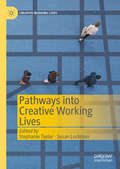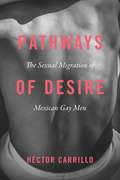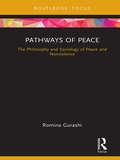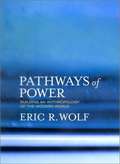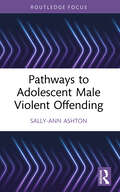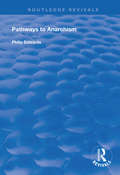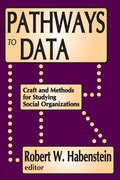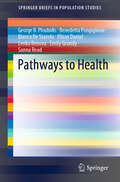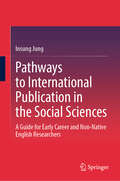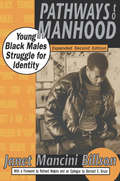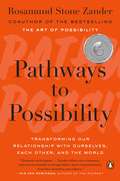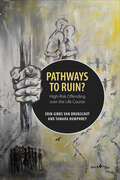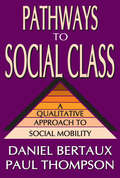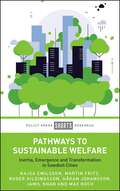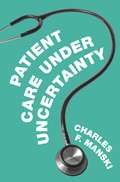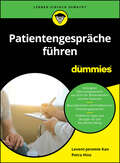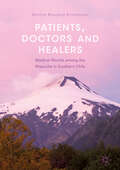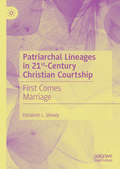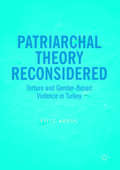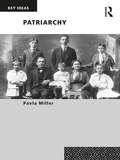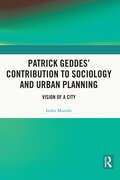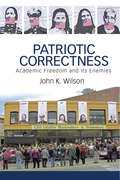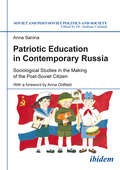- Table View
- List View
Pathways into Creative Working Lives (Creative Working Lives)
by Stephanie Taylor Susan LuckmanThis book presents research on pathways into creative work. The promise of ‘doing what you love’ continues to attract new entrants to the cultural and creative industries. Is that promise betrayed by the realities of pathways into creative work, or does a creative identification offer new personal and professional possibilities in the precarious contexts of contemporary work and employment? Two decades into the 21st century, aspiring creative workers undertake training and higher education courses in increasing numbers. Some attempt to convert personal enthusiasms and amateur activities into income-earning careers. To manage the uncertainties of self-employment, workers may utilise skills developed in other occupations, even developing timely new forms of collective organisation. The collection explores the experience of creative career entrants in numerous national contexts, including Australia, Belgium, China, Ireland, Italy, Finland, the Netherlands, Russia, the US and the UK. Chapters investigate the transitions of new workers and the obstacles they encounter on creative pathways.Chapters 1, 12 and 15 are available open access under a Creative Commons Attribution 4.0 International License via link.springer.com.
Pathways of Desire: The Sexual Migration of Mexican Gay Men
by Héctor CarrilloWith Pathways of Desire, Héctor Carrillo brings us into the lives of Mexican gay men who have left their home country to pursue greater sexual autonomy and sexual freedom in the United States. The groundbreaking ethnographic study brings our attention to the full arc of these men’s migration experiences, from their upbringing in Mexican cities and towns, to their cross-border journeys, to their incorporation into urban gay communities in American cities, and their sexual and romantic relationships with American men. These men’s diverse and fascinating stories demonstrate the intertwining of sexual, economic, and familial motivations for migration. Further, Carrillo shows that sexual globalization must be regarded as a bidirectional, albeit uneven, process of exchange between countries in the global north and the global south. With this approach, Carrillo challenges the view that gay men from countries like Mexico would logically want to migrate to a “more sexually enlightened” country like the United States—a partial and limited understanding, given the dynamic character of sexuality in countries such as Mexico, which are becoming more accepting of sexual diversity. Pathways of Desire also provides a helpful analytical framework for the simultaneous consideration of structural and cultural factors in social scientific studies of sexuality. Carrillo explains the patterns of cross-cultural interaction that sexual migration generates and—at the most practical level—shows how the intricacies of cross-cultural sexual and romantic relations may affect the sexual health and HIV risk of transnational immigrant populations.
Pathways of Peace: The Philosophy and Sociology of Peace and Nonviolence
by Romina GurashiThis book explores the close interconnection that exists between sociological and philosophical scholarship in relation to peace studies. Through an examination of the thought of nine leading philosophers and sociologists in their historical and geographical context, the author considers notions of nonviolent resistance, pacifism and reverse strike, as well as violence theories of conflict, theories of conflict resolution, the problem of war, and political transitions towards democratization. Engaging with the work of Thoreau, Gandhi, Ghaffar Khan, Capitini, Dolci, Bobbio, Galtung, Sharp and Weil, and considering the institutionalisation of peace research, this volume will appeal to scholars and students of sociology, politics and philosophy with interest in peace and security studies, and conflict.
Pathways of Power: Building an Anthropology of the Modern World
by Eric R. WolfPosthumous collection of one of the world's leading anthropologists, spanning well over half a century of scholarship and including both well-known pieces, lesser-known not-easily-accessible pieces, and a few entirely unpublished pieces.
Pathways to Adolescent Male Violent Offending (Routledge Studies in Criminal Behaviour)
by Sally - AshtonThis book differentiates between categories of adolescent male offending and explores the behavioural and social profiles of those who become involved inviolent offending and organized crime. Using self-reported and arrest data, the book examines the key stages of male adolescent offending with a view to early recognition of behaviours that leave young men vulnerable to criminal exploitation and the escalation of violence. It also explains the importance of understanding crime motivations, how young men view themselves when they offend, and the emotions that they experience. Rather than looking at violent offending as a single category of behavior, the book helps readers differentiate between types of adolescent violence and understand the underlying psychological and social causes. It offers an insight into the journey of young people who are criminally exploited and those who become involved in committing acts of serious violence and organized crime. It does so by using data from official records, self-reported offending, and the narratives of young people. Each chapter focuses on a particular stage of offending with a view to early identification, support, and diversion. Pathways to Adolescent Male Violent Offending is aimed at practitioners in youth offending services, youth work, policing, and education. It will also be useful for students of forensic and investigative psychology, criminal justice, policing, and child and adolescent mental health.
Pathways to Anarchism (Routledge Revivals)
by Philip EdwardsFirst published in 1997, this volume challenges the belief that possessive individualists need states to restrain them from trespassing on the natural rights of others or from harming themselves and questions whether anarchy can be sustained to accommodate the long-term self-interests of possessive individualists. Issues discussed include Hobbes’ response to the Foole, Libertarian Anarchism and the inevitability of a minimal state in anarchist society, along with tactics to avoid large wealth differentials.
Pathways to Data: Craft and Methods for Studying Social Organizations
by Robert W. Habenstein"It is much better," observed C. Wright Mills in an essay on intellectual craftsmanship, "to have one account by a working student of how he is going about his work than a dozen 'codifications of procedure' by specialists who often as not have never done much work of consequence." This observation underscores the premise of this book: that there is a need for students to communicate the procedures and strategies of field research they have found consequential in their own studies to the less instructed or less experienced. The contributors to this book are well known researchers and share their field-developed techniques of research craftsmanship. The pathways to data they describe wind in a common direction, toward a concern with research happenings in situations: in agencies, associations, institutions, campaigns, demonstrations, and goal-directed social movements.The selections included in "Pathways to Data" are neither biographies of research projects nor subjective evaluations of personal experiences. Rather, the writers emphasize techniques, operations, and know-how. "Pathways to Data's" chapters are collateral cousins to the collection of research biographies found in "Sociologists at Work", another classic in the field. But the lineage, or progression of thought, traces back to the Webbs' Methods of Social Study, and is most closely related to the Glaser and Strauss volume, "The Discovery of Grounded Theory".The contributors to this book reflect a common concern with organization in the "down home" sense of social bonds opening and closing, of self-involvement, and most importantly social structure. Process is stressed above system, becoming over being. Seen programatically, field methods deliver data to concepts, and techniques are grounded in the heuristic value such data display. Theory is grounded in concepts validated by the effectiveness with which they give meaning to the data. The production of social knowledge is symmetrical, reciprocal, but analytically divisible. The student of society will consequently find an assortment of knowledges that makes large portions of our society more understandable.
Pathways to Health (SpringerBriefs in Population Studies)
by George B. Ploubidis Benedetta Pongiglione Bianca De Stavola Rhian Daniel Lenka Benova Emily Grundy Sanna ReadThis book presents a rigorous enquiry into life course processes that are thought to influence health, integrating the latest methodologies for the study of pathways that link socio-demographic circumstances to health with an emphasis on the mediating factors that lie on these pathways. Following an introductory chapter on the application of formal mediation methods within the life course framework, the book offers insights on the pathways that link early life socio-economic circumstances to physical activity in later life, the role of physical activity as a moderator and/or mediator of the association between fertility history and later life health and the evolution of self-rated health over the life course in two generations born 12 years apart in 20th century Britain. Pathways to Health presents a dynamic view on how to investigate specific hypotheses within the life course framework and enhances the ability of the social science community to investigate specific mechanisms related to public health interventions.
Pathways to International Publication in the Social Sciences: A Guide for Early Career and Non-Native English Researchers
by Insung JungThis guide offers a clear step-by-step approach for graduate students and early-career researchers, especially non-native English speakers, seeking to publish in international journals in the social sciences. It provides practical strategies for preparing, submitting, and refining research papers, helping researchers navigate the challenges of academic publishing. With 21 chapters, the guide covers every stage of writing, revising, and submission, while addressing the unique obstacles faced by non-native English speakers. The guide helps researchers identify reputable journals, avoid predatory ones, and use digital tools to meet international standards. It then provides a structured roadmap that simplifies the publication process, covering steps like journal selection, writing compelling abstracts, and drafting the methods and results sections. By the end of the guide, it is expected that researchers will have a strong first draft or, ideally, a submission-ready manuscript. The guide also addresses language barriers, cultural differences, and unfamiliarity with international conventions. It offers practical solutions for improving English writing, utilizing digital tools, responding to peer reviews, and managing revisions effectively. It emphasizes ethical guidelines like avoiding plagiarism, properly crediting co-authors, and ensuring research transparency to help researchers meet global standards. Unlike other research guides, this one is specifically tailored to early career and non-native English researchers working in social science disciplines. It offers practical strategies and real-world examples to equip researchers—and teachers of research methods and academic writing—with a framework for achieving publishing success in global academia.
Pathways to Manhood: Young Black Males Struggle for Identity
by Janet Mancini BillsonIn Pathways to Manhood, published in cloth as Strategic Styles: Coping in the Inner City, Janet Maricini Billson studies five young boys who grew up in Roxbury, Massachusetts, during the Intense racial and political turmoil of the late 1960s and early 1970s. Using data from Harvard's Pathways to Identity project, she analyzes how healthy ego striving develops in the social and physical decay of an Inner-city environment.The author draws a rich and absorbing portrait of each boy and of his life. Although they grew up in the same social context, the boys became very different individuals. In a new preface to this expanded edition, Billson maintains that it is still vitally Important to understand the coping styles that young black males develop in the face of adversity.Bernard E. Bruce traces what happened to the five boys, who are now men In their forties, in his poignant epilogue, "From Boys to Men." A new chapter on Intervention strategies shows how parents, teachers, and others who work with inner-city youth can most effectively support positive coping styles. Graphic representations help visualize both the styles and the intervention strategies.This classic book is a valued resource for parents; for those who work in the helping professions, education, and the criminal justice system; and for students of sociological theory, social psychology, human development, and race relations.
Pathways to Possibility: Transforming Our Relationship with Ourselves, Each Other, and the World
by Rosamund Stone Zander"Rosamund Zander is a miracle. Her generous voice will resonate with you, change you and help you create work that matters." --Seth Godin, author of The Icarus Deception"Fresh, compelling, and uplifting." --Booklist The bestselling author of The Art of Possibility returns with a new vision for achieving true human fulfillmentIn this powerful and inspiring book, family systems therapist and executive coach Rosamund Stone Zander invites readers to shed the childhood stories that hold us back, and enter a realm of true maturity and fulfillment, where limitless growth becomes possible. As children, we develop stories about how the world works, most of which get improved upon and amended over time. But some do not, even as we mature in other ways. Opinionated, self-centered and fear-driven, these "child stories" are the source of the behavioral and emotional patterns that hold us back. When we learn to identify and rewrite these stories, we can do remarkable, even magical things. Zander shows us that life is a story we tell ourselves, and that we have the power to change that story. She illuminates how breaking old patterns and telling a new story can transform not just our own lives, but also our relationships with others--whether in a marriage, a classroom, or a business. Finally, she demonstrates how, with this new understanding of ourselves and our place within an interconnected world, we can take powerful action in the collective interest, and gain a sense of deep connection to the universe. This galvanizing book expands our notions of how much we can grow and change, whether we can affect others or the world at large, and how much freedom and joy we can experience. Stimulating and profound, it is the perfect companion to her beloved first book, The Art of Possibility.From the Hardcover edition.
Pathways to Ruin: High-Risk Offending over the Life Course
by Erin Gibbs Van Brunschot Tamara HumphreyIndividuals who have committed a number of crimes over their lifetimes have had complex, multi-faceted life experiences often characterized by extreme disadvantage and victimization. Those who are formally designated as "high-risk" by the Canadian criminal justice system often have a record of violent or sexual crimes. As a result, they are usually subject to additional monitoring in the community after completing a prison sentence. Pathways to Ruin disentangles the numerous elements and pathways that lead to high rates of reoffending by focusing on developmental periods of childhood, adolescence, and adulthood. The book uses a case-study approach to consider individuals’ entire crime pathway by examining the circumstances and factors that contribute to assumptions or official designations of "high-risk" behaviour. Erin Gibbs Van Brunschot and Tamara Humphrey overhaul society’s popular crime narratives and instead draw on sociological and criminological perspectives to identify historical, social, and personal contexts that appear to increase the likelihood of reoffending. They also consider how negative life experiences may be addressed to circumvent trajectories of serious offending. Reducing the social distance that the "law-abiding" public may feel towards marginalized groups, Pathways to Ruin details how legal systems could better serve these individuals, and acknowledges the many missed opportunities for compassion.
Pathways to Social Class: A Qualitative Approach to Social Mobility
by Paul Thompson Daniel BertauxCalling for a broader, new approach to social mobility research, Pathways to Social Class: A Qualitative Approach to Social Mobility moves beyond pure statistics to use qualitative techniques-such as life stories and family case studies-to examine more closely the dynamics of mobility and address more fundamental sociological questions.
Pathways to Sustainable Welfare: Inertia, Emergence and Transformation in Swedish Cities
by Kajsa Emilsson Martin Fritz Roger Hildingsson Håkan Johansson Jamil Khan Max KochAvailable open access digitally under CC-BY-NC-ND licence. Pathways to Sustainable Welfare critically examines how cities can address the dual challenges of climate change and sustainability while ensuring the welfare of their populations. Focused on three Swedish cities, it explores the integration of environmental and welfare concerns in local policies, urban movements and public opinions. Based on theories of inertia, emergence and transformation, it identifies factors driving or obstructing sustainable welfare advancements. This book is a crucial resource for scholars interested in sustainable transformation, urban governance and social policy. It offers frameworks and empirical evidence relevant to academics, policy makers and practitioners seeking to understand and engage in urban sustainable welfare development.
Patient Care under Uncertainty
by Charles F. ManskiHow cutting-edge economics can improve decision-making methods for doctorsAlthough uncertainty is a common element of patient care, it has largely been overlooked in research on evidence-based medicine. Patient Care under Uncertainty strives to correct this glaring omission. Applying the tools of economics to medical decision making, Charles Manski shows how uncertainty influences every stage, from risk analysis to treatment, and how this can be reasonably confronted.In the language of econometrics, uncertainty refers to the inadequacy of available evidence and knowledge to yield accurate information on outcomes. In the context of health care, a common example is a choice between periodic surveillance or aggressive treatment of patients at risk for a potential disease, such as women prone to breast cancer. While these choices make use of data analysis, Manski demonstrates how statistical imprecision and identification problems often undermine clinical research and practice. Reviewing prevailing practices in contemporary medicine, he discusses the controversy regarding whether clinicians should adhere to evidence-based guidelines or exercise their own judgment. He also critiques the wishful extrapolation of research findings from randomized trials to clinical practice. Exploring ways to make more sensible judgments with available data, to credibly use evidence, and to better train clinicians, Manski helps practitioners and patients face uncertainties honestly. He concludes by examining patient care from a public health perspective and the management of uncertainty in drug approvals.Rigorously interrogating current practices in medicine, Patient Care under Uncertainty explains why predictability in the field has been limited and furnishes criteria for more cogent steps forward.
Patient Safety Coaching: Transforming Healthcare Culture
by Susanne KnowlesThis book argues that patient safety is the cornerstone of high-quality healthcare, and that we need to highlight the positive impact of a Safety-11 approach to risk management to improve the quality of patient services and care. Moreover, the author emphasizes the importance of upskilling leaders with coaching capability within the healthcare facility so that decisions can be made quickly to prevent adverse events. In light of this, this book aims to equip clinical leaders across all levels and in all areas of healthcare organizations with the knowledge and skills to develop a patient safety culture in their team and organization based on evidence-based contemporary research into patient safety practices. The author also proposes strengthening leader capability by outlining how they can create a psychologically safe working environment and adopt a coaching leadership style that promotes staff wellbeing and patient care. This book provides strategies for leaders so they can ensure staff wellbeing at work and a patient-centric approach to patient care. It outlines how clinical leaders can support team members to reduce their stress, better utilize their strengths, practice mindfulness, remain positive, and build resilience in the face of adversity, whilst also fostering a workplace culture of trust, support, and compassion. Lastly, this book aims to provide high-level executives and experienced clinical leaders with contemporary knowledge of governance issues and the best practice methods concerning patient safety as a quality improvement strategy.
Patientengespräche führen für Dummies (Für Dummies)
by Levent-Jeremie Kan Petra HinzEin unverblümt praxisnahes Handbuch für mehr Verständnis für beide Seiten Verstehen und verstanden werden – nicht selten ein Problem zwischen Behandelnden und Patient. Das kann dieses Buch ändern. Aus verschiedenen Perspektiven stellen Ihnen die Autoren die Ursachen des vielschichtigen Kommunikationsproblems differenziert sowie zielgerichtet vor. In Form von Denkanstößen, Empfehlungen und praktischen Übungen bieten Sie Ihnen auch greifbare Lösungen dazu an. Dabei erklären sie, wie Sie sie erfolgreich auf Ihre individuelle Situation übertragen. In welche Themenschwerpunkte Sie sich hineinarbeiten, welche Ziele Sie sich setzen – all das bleibt Ihnen überlassen. Sie erfahren Was Behandelnder und Patienten jeweils voneinander erwarten Wie Sie Fettnäpfchen und Konflikte vermeiden Welchen Einfluss Ihre Patientengespräche auf Ihren beruflichen Erfolg nehmen
Patients, Doctors and Healers
by Dorthe Brogård KristensenRecognizing the interplay between biomedicine and indigenous medicine among the Mapuche in Southern Chile, this book explores notions of culture and personhood through the bodily experiences and medical choices of patients. Through case studies of patients in the context of medical pluralism, Kristensen argues that medical practices are powerful social symbol indicative of overarching socio-political processes. As certain types of extreme and violent experiences–known as olvidos–lack a framework that allows them to be expressed openly, they therefore surface as symptoms of an illness, often with no apparent organic pathology. In these contexts, indigenous medicine, thanks to its sensitivity to socio-political contexts, provides a space for articulation and management of collective experiences and suffering among patients in Southern Chile.
Patriarchal Lineages in 21st-Century Christian Courtship: First Comes Marriage
by Elizabeth L. ShivelyDrawing from a study of courtship media and ethnographic work at purity retreats and home-school conventions across the Midwest, this is the first inquiry into modern Christian courtship, an alternative to dating that asks young people to avoid both romance and sex until they are ready to be married. Bridging sociological and historical studies of American Christianity with youth and girlhood studies literatures, Elizabeth Shively finds that the courtship system is designed to shore up the patriarchal nuclear family structure at the center of conservative Christianity and ensure predictability in the face of emerging adulthood: single young women work to embody ideals of “luminous femininity” and model themselves after archetypes such as the “Proverbs 31 woman,” the “stay-at-home-daughter,” and the “mission-minded girl,” and courting couples strive to “guard their hearts” against premature emotional intimacy. Nonetheless, participants report that courtship, like other relationships, inevitably carries an element of risk, and it ultimately fails to offer a substantial challenge to the to the sexist realities of youth dating culture.
Patriarchal Precedents: Sexuality and Social Relations (Routledge Revivals)
by Rosalind CowardFirst published in 1983, Patriarchal Precedents is an excavation of the term patriarchy. Rosalind Coward shoes how the debates about patriarchy and matriarchy were crucial to social theories in the nineteenth century, discussing how the resolution of these debates resulted in our present ways of (mis)understanding the family, sexual relations and sexual characteristics. Rosalind Coward argues that the violent debates around patriarchy tell a salutary tale about how the term presupposed as much as it set out to explain. She demonstrates how it was used in Marxism and psychoanalysis in ways which blocked any radical thinking about sexual relations, and how the arguments against the term patriarchy within anthropology still have to be taken seriously. She argues that in order to advance our understanding of how power is exercised in sexual relations, of the place which sexual relations have within society and the construction of sexual characteristics, a series of presuppositions about sexual relations must now be cleared away. This book will be of interest to students of gender studies, women's studies, sexuality, men' s studies, sociology and anthropology.
Patriarchal Theory Reconsidered
by Filiz AkgulThis study analyzes male-female violence in comparison to state-citizen violence. The author argues that norms and values in Turkey are a reflection of processes that accommodate oppression, the intersection of which develops the argument that 'women are to men, what the citizen is for the state, in the context of Turkey. ' Gender theory, and patriarchal theory in particular, are explored in this book to describe the logic and design of gender-based violence and its relationship with political sociology.
Patriarchy
by Pavla Miller"In this major contribution to European social history, Miller has succeeded in doing to history what Richard Wagner did to music -- weaving together powerful motifs with dramatic results. " -- Choice"[Miller's book] wrestles with issues as basic as the historical construction of the Western personality and its connections with how Western societies have organized the state, the economy, the family, and intimate everyday life. " -- MaryJo MaynesThis wide-ranging study of familial, political, and economic change in the West between the sixteenth and the nineteenth centuries is organized around the two themes of the fall of a patriarchalist social order and the reformist movement to instill self-mastery into subject populations -- and how those societal shifts transformed state school systems.
Patrick Geddes’ Contribution to Sociology and Urban Planning: Vision of A City
by Indra MunshiThis book explores Patrick Geddes’s significant contributions to urban planning and sociology. His vision of the city, rooted in the principles of social development and preservation of cultural and ecological resources, has inspired generations of urban planners, architects and social scientists engaged with contemporary urban issues. The book discusses Geddes’ early experiments with urban renewal in Edinburgh, the famous Cities and Town Planning Exhibition and his work in India for the improvement of cities and towns with minimal financial and human cost. It examines the theoretical underpinnings of his ideas in relation to issues such as better housing and health; the preservation of history and culture; the role of a citizen; university and urban renewal; and the contemporary urban ecological crisis among others. Furthermore, it looks at the question of sustainability in the context of Geddes’ vision of a more humane, social, natural, and aesthetic town and city. A comprehensive review of Patrick Geddes’s ideas, this book underlines the relevance of his work to contemporary urban concerns and issues, especially in India. It will be of interest to scholars and researchers of sociology, urban studies, city planning, urban sociology, architecture, human geography, urban geography, settlement studies, development studies and environmental sustainability.
Patriotic Correctness: Academic Freedom and Its Enemies
by John K. WilsonAfter 9/11, liberal professors and students faced an onslaught of attacks on their patriotism and academic freedom. In a lively narrative this book tells the story of attacks on academic freedom in the past five years. It highlights nationally prominent and lesser known cases, drawing upon media reports, university documents, and reports and studies seldom seen by the public. It shows how conservative attacks on higher education distort the facts in order to pursue an assault on liberal ideas. A wave of Web sites and think-tanks urge students to spy on their professors for any sign of deviation from the new PC: Patriotic Correctness. Free speech on campus is facing its greatest threat in a half century, and Patriotic Correctness: Academic Freedom and Its Enemies documents the danger to rights and looks to solutions for ensuring and promoting the free exchange of ideas requisite in any thriving democracy.
Patriotic Education in Contemporary Russia: Sociological Studies in the Making of the Post-Soviet Citizen (Soviet and Post-Soviet Politics and Society #168)
by Anna SaninaThis book outlines the complexities, contestation, and contradictions in the formal organization and contents of patriotic education in post-Soviet Russia. While the topics of patriotism and patriotic education are highly political and politicized, this study approaches them from a more sociological perspective. It is based on a variety of sources and empirical data, including the indicators and budgets of federal and regional patriotic-education programs and on field research. The book explores in depth all major agents of patriotic education in Russia, such as the government, schools, youth associations, churches, and the film/cartoon industry. It traces the development of governmental patriotic programs in recent decades, discusses how the Soviet past and political traditions influence today's system of patriotic education, and presents numerous case studies illustrating real-life processes in current patriotic education.
